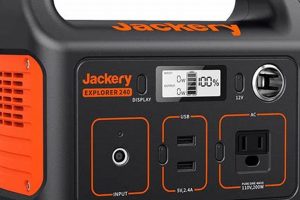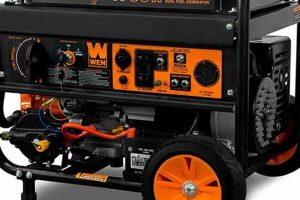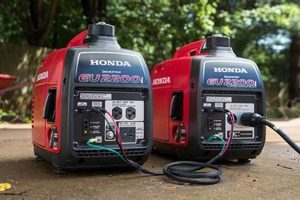Operating electrical equipment in wet conditions presents inherent safety risks. Exposure of a portable generator to rain, snow, or other sources of moisture can lead to electrical shocks, short circuits, and damage to the generator’s components. For example, water entering the generator’s outlets can create a path for electricity to flow to the ground, posing a severe hazard to anyone nearby.
Understanding the risks associated with operating electrical devices in wet environments is critical for safe generator use. Preventing water damage prolongs the generator’s lifespan and ensures reliable power during emergencies. Historically, generators have played a crucial role in providing backup power during natural disasters and other outages. Protecting these valuable resources from the elements ensures their availability when needed most.
This article will explore safe operating procedures for portable generators, including proper grounding techniques, weather protection strategies, and emergency shutdown procedures. Additionally, it will cover the importance of routine maintenance and inspection to identify and address potential water damage.
Safe Operating Practices for Portable Generators in Wet Conditions
Protecting a portable generator from moisture is crucial for safe and reliable operation. These tips outline essential precautions to prevent water damage and ensure operator safety.
Tip 1: Never Operate in Direct Rain or Snow: Generators should always be protected from direct precipitation. Utilize a sturdy canopy or a well-ventilated, waterproof enclosure specifically designed for generators.
Tip 2: Elevate the Generator: Position the generator on a dry, elevated surface, such as a wooden platform or bricks, to prevent contact with standing water.
Tip 3: Dry Hands Before Operation: Ensure hands are completely dry before handling the generator, its controls, or any connected cords.
Tip 4: Inspect for Damage: Before each use, thoroughly inspect the generator for any signs of water damage, including cracks, corrosion, or loose connections. If damage is found, do not operate the generator and consult a qualified technician.
Tip 5: Proper Grounding: Always ground the generator according to manufacturer instructions to minimize the risk of electrical shock.
Tip 6: Safe Storage: Store the generator in a dry, protected location, away from moisture and extreme temperatures.
Tip 7: Consult the Manual: Always refer to the manufacturer’s instructions for specific safety guidelines and recommendations related to operating the generator in various weather conditions.
Adhering to these safety precautions will help ensure the longevity of the generator and, most importantly, the safety of individuals operating or in proximity to the equipment.
By implementing these preventative measures, users can mitigate the risks associated with operating portable generators in wet environments and ensure a reliable power source when needed.
1. Electrical Hazard
The intersection of electricity and water presents a significant danger, and portable generators operating in wet conditions exacerbate this risk. Understanding the potential electrical hazards associated with moisture exposure is crucial for safe generator operation.
- Electrocution
Water conducts electricity, creating a path for electrical current to flow to the ground. If a generator is wet and a person comes into contact with it, they can become part of that electrical circuit, resulting in potentially fatal electrocution. Even seemingly minor contact with a wet generator can deliver a dangerous shock.
- Ground Faults
Water can compromise the insulation of electrical components within the generator, leading to ground faults. These faults occur when the electrical current flows through an unintended path to the ground, bypassing the designed circuitry. Ground faults can cause overheating, damage to the generator, and potential fires.
- Short Circuits
Moisture can create a bridge between electrical conductors within the generator, causing a short circuit. Short circuits result in a rapid, uncontrolled flow of electricity, generating intense heat and potentially igniting flammable materials nearby. This poses a significant fire hazard and can permanently damage the generator.
- Equipment Damage
Repeated exposure to moisture can corrode and damage internal generator components. This can lead to malfunctions, reduced efficiency, and ultimately, premature failure of the equipment. Protecting the generator from moisture is essential for maintaining its operational lifespan.
These potential electrical hazards underscore the importance of keeping portable generators dry during operation. Ignoring these risks can lead to serious consequences, ranging from equipment damage to severe injury or even death. Implementing appropriate safety measures, including proper grounding, dry operation, and regular maintenance, is paramount to mitigating these risks and ensuring safe generator usage.
2. Corrosion and Damage
Exposure to moisture accelerates corrosion in portable generators. Water, especially in combination with airborne salts and pollutants, reacts with metallic components, leading to rust and other forms of corrosion. This degradation weakens the generator’s structural integrity and compromises electrical connections. For instance, corrosion of the generator’s frame can compromise its stability, while corrosion affecting electrical wiring can lead to intermittent operation or complete failure. The effects of corrosion are often gradual but cumulative, potentially resulting in costly repairs or premature replacement of the generator.
Internal components, including the alternator windings and fuel system, are also susceptible to water damage. Ingress of water into the alternator can lead to short circuits and irreversible damage to the windings. Water contamination in the fuel system can cause corrosion within the fuel tank and carburetor, leading to engine performance issues and starting difficulties. In coastal areas, saltwater exposure presents an even greater threat due to its higher conductivity and corrosive properties. A generator left unprotected in a humid, salty environment will likely experience accelerated corrosion and require more frequent maintenance or replacement.
Preventing corrosion and water damage requires proactive measures. Storing the generator in a dry, protected location is essential, as is covering the unit during periods of inactivity or inclement weather. Regular inspections for signs of corrosion, particularly in areas with exposed metal, should be part of routine maintenance. Addressing corrosion promptly, through cleaning and application of protective coatings, can extend the generator’s lifespan significantly. Understanding the link between moisture exposure and corrosion is fundamental to responsible generator ownership and maximizing the equipment’s longevity.
3. Short Circuits
Water significantly increases the risk of short circuits in portable generators. A short circuit occurs when an unintended path of low resistance allows electricity to flow directly between two points with different electrical potentials. In a wet generator, water can bridge the insulation separating electrical conductors, creating this low-resistance pathway. This bypasses the intended circuit, resulting in a surge of current and potentially catastrophic consequences. The high current generated during a short circuit produces significant heat, which can melt wiring insulation, damage components, and potentially ignite flammable materials nearby. The presence of water amplifies this hazard, as it can spread the electrical arc and contribute to the ignition of surrounding materials. For example, water accumulating inside the generator’s housing can create a conductive path between exposed wires, leading to a short circuit that damages internal components or even starts a fire.
The severity of a short circuit in a wet generator depends on several factors, including the volume of water present, the voltage of the electrical system, and the protective measures in place. Generators typically incorporate circuit breakers or fuses designed to interrupt the flow of electricity in the event of a short circuit, mitigating the risk of fire or extensive damage. However, these safety mechanisms might not always provide complete protection, especially if the generator is severely compromised by water ingress. For instance, if water has significantly corroded internal wiring, the resulting short circuit could overwhelm the circuit breaker’s capacity, leading to sustained arcing and potential fire. The risk of electrocution also escalates significantly when a short circuit occurs in a wet environment, as the water can conduct the electrical current to anyone in contact with the generator or surrounding wet surfaces.
Preventing short circuits in portable generators requires diligent protection against moisture. Operating the generator under a waterproof cover or in a well-ventilated enclosure is crucial, especially during inclement weather. Regular inspections for signs of water damage or corrosion can help identify potential vulnerabilities before a short circuit occurs. Proper grounding of the generator provides an additional layer of safety by diverting fault currents away from the operator and into the earth. Understanding the connection between water exposure and short circuits is essential for ensuring safe generator operation and preventing potentially hazardous situations.
4. Safety Precautions
Safety precautions are essential when considering the potential for portable generator exposure to moisture. The inherent dangers of operating electrical equipment in wet conditions necessitate a proactive approach to safety. A failure to observe appropriate safety measures significantly increases the risk of electrical hazards, equipment damage, and potentially life-threatening situations. Cause and effect are directly linked; water exposure can lead to short circuits, corrosion, and electrocution, while adherence to safety protocols mitigates these risks. One real-life example is the increased risk of electrocution during post-hurricane cleanup when generators are often used in wet environments. Without proper grounding and protection from the elements, individuals operating generators face a heightened risk of fatal shock.
Safety precautions are not merely a component of operating a portable generator in wet conditions; they are the foundation upon which safe operation depends. These precautions encompass a range of measures, including proper grounding, the use of weatherproof enclosures, regular inspections for water damage, and ensuring dry hands before operating the equipment. Each precaution plays a vital role in mitigating specific risks. Grounding, for instance, provides a safe path for fault currents to flow to the earth, reducing the risk of electrocution. Using a weatherproof enclosure prevents water from entering the generator’s internal components, protecting against short circuits and corrosion. These precautions are interconnected and work synergistically to enhance safety.
Understanding the practical significance of these safety precautions is paramount for responsible generator ownership. This understanding translates into informed decision-making and safe operating practices. The consequences of neglecting safety precautions can range from equipment malfunction and costly repairs to severe injury or fatality. By prioritizing safety and adhering to established guidelines, individuals can effectively mitigate risks and ensure the safe and reliable operation of portable generators, even in challenging environmental conditions. Proactive safety measures are an investment in both equipment longevity and personal well-being.
5. Protective Measures
Protective measures form a critical barrier against the detrimental effects of moisture on portable generators. The central question, “Can my portable generator get wet?”, underscores the need for these measures. Cause and effect are directly related: exposure to water can cause corrosion, short circuits, and electrical hazards, while protective measures mitigate these risks. These measures are not merely a component of safe generator operation in wet conditions; they are the foundation upon which safe operation depends. Real-world scenarios, such as operating a generator during or after a flood, highlight the critical importance of protective measures. Without adequate protection, the generator becomes a substantial hazard, risking both equipment damage and personal injury.
Several practical protective measures exist. Waterproof enclosures, designed specifically for generators, provide a comprehensive shield against rain, snow, and splashing water. Elevating the generator on a dry platform further minimizes contact with standing water or saturated ground. Regular inspections are crucial for identifying potential vulnerabilities, such as cracks in the enclosure or signs of corrosion. Addressing these issues promptly prevents minor damage from escalating into major problems. For instance, a small crack in a protective cover, if left unaddressed, can allow water to seep into the generator’s electrical components, leading to corrosion and eventual malfunction. Applying a waterproof sealant to the crack is a simple yet effective protective measure that prevents further damage and ensures continued safe operation.
Investing in and correctly implementing protective measures ensures the generator’s longevity and safe operation. The practical significance of this understanding lies in the prevention of potentially hazardous situations. While generators provide essential power during emergencies, they also present inherent risks when exposed to moisture. Protective measures bridge this gap, allowing for safe and reliable power generation even in challenging environmental conditions. Neglecting these measures, conversely, elevates the risks of electrical hazards and equipment damage, undermining the generator’s intended purpose and potentially jeopardizing safety. The choice between proactive protection and reactive repairs is clear; proactive measures represent a sensible and responsible approach to generator ownership, ensuring both the equipment’s longevity and the operator’s well-being.
Frequently Asked Questions
This FAQ section addresses common concerns regarding portable generator operation in wet conditions.
Question 1: Can a portable generator be used in light rain?
Operating a portable generator in any amount of rain is strongly discouraged. Even light rain can introduce moisture into electrical components, increasing the risk of short circuits and electrical hazards. A waterproof enclosure is essential for safe operation in wet conditions.
Question 2: What happens if a portable generator gets splashed with water?
If a generator is splashed with water, it should be immediately shut down and allowed to dry completely before restarting. Thoroughly inspect the unit for signs of water ingress and consult a qualified technician if any damage is suspected.
Question 3: Is it safe to operate a generator on wet ground?
No, operating a generator on wet ground significantly increases the risk of electrical hazards. Always elevate the generator on a dry, stable surface, such as a wooden platform or bricks.
Question 4: Are all portable generators waterproof?
No, most portable generators are not waterproof. While some models offer increased weather resistance, it’s crucial to consult the manufacturer’s specifications and take appropriate precautions to protect the generator from moisture.
Question 5: How can one protect a generator from rain and snow?
A purpose-built waterproof enclosure or canopy provides the best protection from rain and snow. Ensure the enclosure is adequately ventilated to prevent carbon monoxide buildup.
Question 6: What should one do if a generator gets submerged in water?
A generator submerged in water should not be used. Consult a qualified technician to assess the extent of the damage and determine if the generator can be safely repaired. Attempting to operate a submerged generator can be extremely dangerous.
Prioritizing safety is paramount when operating a portable generator in any environment. Understanding the risks associated with moisture exposure and adhering to recommended safety precautions are essential for preventing accidents and ensuring the longevity of the equipment.
The next section will discuss best practices for storing portable generators to prevent moisture damage.
Conclusion
The question of whether a portable generator can get wet has been thoroughly explored, revealing the inherent risks associated with moisture exposure. Electrical hazards, including electrocution, pose significant threats. Corrosion and resulting damage compromise the generator’s structural integrity and operational lifespan. Short circuits, triggered by water bridging electrical conductors, can lead to equipment failure and fire hazards. Safety precautions, including proper grounding and the use of protective enclosures, are not merely suggestions but essential requirements for safe operation. Protective measures represent a proactive approach to risk mitigation, safeguarding both equipment and individuals.
Safe and reliable portable generator operation requires a thorough understanding of moisture-related risks and a commitment to implementing appropriate safety measures. Prioritizing generator protection safeguards against potential hazards, ensuring reliable power generation when needed most. Diligence in maintaining a dry operating environment and adhering to established safety protocols are fundamental to responsible generator ownership and critical for preventing accidents. Portable generators are valuable resources; protecting them from moisture ensures their availability and extends their operational life, contributing to safety and preparedness.






